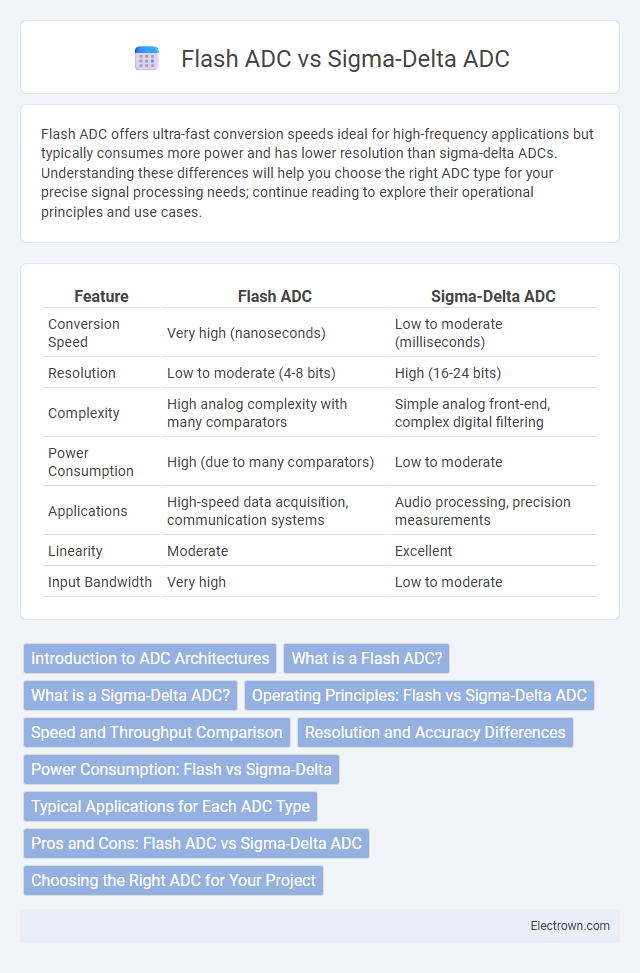Flash ADC offers ultra-fast conversion speeds ideal for high-frequency applications but typically consumes more power and has lower resolution than sigma-delta ADCs. Understanding these differences will help you choose the right ADC type for your precise signal processing needs; continue reading to explore their operational principles and use cases.
Table of Comparison
| Feature | Flash ADC | Sigma-Delta ADC |
|---|---|---|
| Conversion Speed | Very high (nanoseconds) | Low to moderate (milliseconds) |
| Resolution | Low to moderate (4-8 bits) | High (16-24 bits) |
| Complexity | High analog complexity with many comparators | Simple analog front-end, complex digital filtering |
| Power Consumption | High (due to many comparators) | Low to moderate |
| Applications | High-speed data acquisition, communication systems | Audio processing, precision measurements |
| Linearity | Moderate | Excellent |
| Input Bandwidth | Very high | Low to moderate |
Introduction to ADC Architectures
Flash ADCs utilize a parallel comparator array for ultra-fast conversion, ideal for high-speed applications where sampling rate is critical. Sigma-delta ADCs employ oversampling and noise shaping techniques to achieve high resolution and accuracy, making them suitable for audio and precision measurement systems. Understanding these architectures helps you select the right ADC based on speed versus resolution requirements in your design.
What is a Flash ADC?
A Flash ADC, also known as a parallel ADC, converts analog signals to digital signals instantaneously by utilizing a series of comparators operating simultaneously. It is the fastest type of ADC due to its parallel architecture, making it ideal for high-speed applications such as radar and digital oscilloscopes. Your choice of a Flash ADC depends on the need for rapid conversion rates, typically reaching several gigasamples per second, while consuming higher power compared to other ADC types like sigma-delta ADCs.
What is a Sigma-Delta ADC?
A Sigma-Delta ADC is a high-resolution analog-to-digital converter that employs oversampling and noise shaping to achieve precise signal conversion. Unlike Flash ADCs, which use parallel comparators for ultra-fast conversion but lower resolution, Sigma-Delta ADCs trade speed for accuracy by converting analog signals into a high-frequency bitstream. This technique makes Sigma-Delta ADCs ideal for applications requiring exceptional dynamic range and low noise, such as audio processing and instrumentation measurements.
Operating Principles: Flash vs Sigma-Delta ADC
Flash ADC operates using a parallel array of comparators to convert an analog input signal into a digital output almost instantaneously, enabling ultra-high speed conversion suitable for applications like radar and high-frequency communications. Sigma-Delta ADC relies on oversampling and noise shaping with a feedback loop and digital filtering to achieve high resolution and accuracy, commonly used in audio and instrumentation systems. Your choice depends on whether you prioritize speed with Flash ADC or precision and noise performance with Sigma-Delta ADC.
Speed and Throughput Comparison
Flash ADCs provide ultra-high-speed conversion with throughput rates often exceeding several gigasamples per second (GSPS), making them ideal for applications requiring rapid signal processing. In contrast, sigma-delta ADCs offer lower throughput, typically in the range of hundreds of kilohertz to a few megahertz, but excel in achieving high resolution with oversampling and noise shaping techniques. Your choice between these ADC types depends on whether speed or precision is the priority in your electronic system design.
Resolution and Accuracy Differences
Flash ADCs deliver high-speed conversion with lower resolution, typically around 6 to 8 bits, due to their parallel comparator architecture, which limits accuracy. Sigma-delta ADCs achieve significantly higher resolution, often exceeding 16 bits, by employing oversampling and noise-shaping techniques that enhance accuracy over slower conversion rates. The trade-off between these two ADC types centers on speed versus precision, where Flash ADCs favor rapid conversion at the expense of fine resolution, and sigma-delta ADCs prioritize accuracy with increased conversion time.
Power Consumption: Flash vs Sigma-Delta
Flash ADCs typically consume significantly more power due to their parallel comparator architecture and high-speed operation, making them less ideal for low-power applications. Sigma-delta ADCs, on the other hand, use oversampling and noise shaping techniques that enable lower power consumption, especially in high-resolution and low-bandwidth scenarios. Your choice should consider power efficiency requirements alongside speed and resolution for optimal performance.
Typical Applications for Each ADC Type
Flash ADCs are commonly used in high-speed applications such as digital oscilloscopes, radar systems, and communication receivers where rapid conversion of analog signals to digital form is crucial. Sigma-delta ADCs excel in high-resolution, low-frequency measurements found in audio processing, industrial sensor systems, and precision instrumentation due to their accuracy and noise-shaping capabilities. Choosing between these ADC types depends on the application's speed requirements and resolution priorities.
Pros and Cons: Flash ADC vs Sigma-Delta ADC
Flash ADC offers ultra-fast conversion speeds ideal for high-frequency applications but suffers from high power consumption and increased complexity with higher bit resolution. Sigma-Delta ADC provides excellent noise performance and high resolution at lower speeds, making it suitable for audio and precision measurement but less effective in real-time high-speed scenarios. Your choice depends on whether speed or accuracy is the priority in your specific application.
Choosing the Right ADC for Your Project
Flash ADCs deliver ultra-fast conversion speeds ideal for high-frequency applications like radar and digital oscilloscopes, offering lower resolution but minimal latency. Sigma-delta ADCs provide higher resolution with excellent noise shaping, making them perfect for audio processing and precise measurement tasks where accuracy outweighs speed. Your project's requirements for sampling rate, resolution, and noise tolerance determine which ADC type best balances performance and cost effectiveness.
Flash ADC vs sigma-delta ADC Infographic

 electrown.com
electrown.com